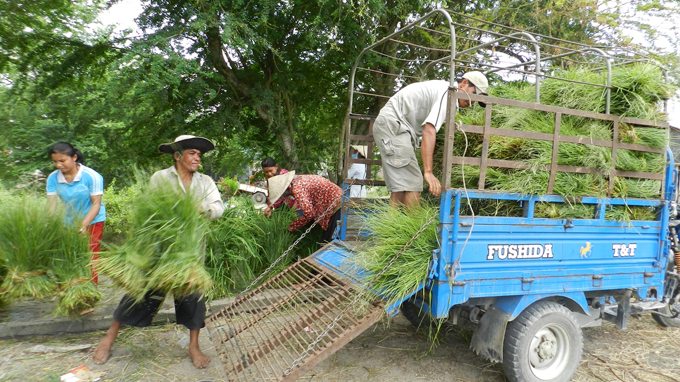People in the Mekong Delta province of An Giang, including Khmer ethnic minorities, have recently transformed grass collecting into a thriving business.
On the roads in Tri Ton District’s Bay Nui Commune, carts loaded with fresh grass are seen traveling back and forth every day. Their customers are local households that raise cattle.
Although local residents primarily feed straw to their cattle, the animals need fresh grass to snack on between main meals.
This area used to be home to vast grasslands, which would provide abundant fresh grass for the cattle. Cows here are particularly known for yielding high-quality, tender meat.
However, having been inundated with water, grazing lands have been shrinking considerably to denser crops, resulting in a serious shortage of fresh grass.
Grass collectors come along
With such a high demand for fresh grass, a number of poor people who do not have land to cultivate have switched to collecting grass and selling them to local cattle keepers.
Over time, more people have been engaged in the business and professionalizing it in the process.
Grass collectors usually have to travel as far as southernmost Kien Giang Province, about an hour ride from An Giang, for better harvests.
According to Le Van Na, a local grass collector, the picked grass should be piled so that it fits a cow’s neck.
The grass is then peddled along the roads, where cattle farmers stand waiting to buy the fresh grass.
Na said that his entire family collects some 300 piles and earns around VND400,000 (US$20) a day, with an armful of grass fetching circa VND2,000.
A market for grass collectors
Five years ago, the O Lam grass market was formed in O Lam Commune, Tri Ton District. The market is almost always bursting with activity and commotion on the days it is held.
“If we fed our cattle only straw, they would be sickly and unable to work properly or yield good meat. Most local cattle keepers rely on the market for constant supplies of fresh grass,” said Chau Dinh, a regular customer.
“Fresh grass is always in high demand, as the cattle herds here keep expanding. We sometimes don’t have enough to sell,” said Chau Mone, a Khmer ethnic minority grass collector/peddler.
According to Bui Thanh Tung, deputy chair of the O Lam Commune People’s Committee, there are times when some hundred grass peddlers gather at the market at one time.
“Apart from offering a good supply of cattle feed, grass collecting provides poor locals with some income, particularly when there is no crop to harvest,” Tung noted.
Chau Soc Kha, a Khmer farmer, carries some 30 grass collectors on his small truck for a fee to Kien Giang Province every day.
These people work hard to collect several tons of grass daily before transporting the loads back to the O Lam market.
Khmer farmer said that a local can collect up to around 100 piles of grass of several varieties each day. They usually keep some piles for their own cattle while selling the rest.
Alternative cattle feed
According to Ly Van Chinh, an agriculture and rural development official of An Giang’s Tri Ton District, the locality is home to roughly 22,000 cattle heads.
The local government is working to instruct farmers on how to make use of spare land to grow different kinds of grass to add to the natural supply.
Projects on growing corn as an alternative to grass are also being developed.
Farmers will make full use of entire corn plants, which are even richer in nutrition than grass, as cattle feed when grass is harder to come by at certain times.



















































